 |
 |
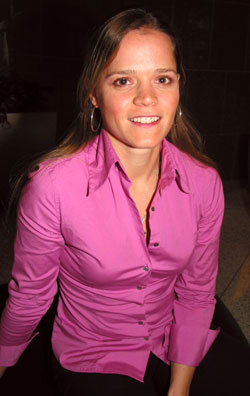
|
|
Hanna Hildenbrand, M.S., Occupational Therapist, Senior Staff, Clinical Center, National Institutes of Health, Bethesda, Maryland
|
1. I chose this career becasue...
2. My typical workday involves...
3. What I like best/least about my work...
4. My career goals are...
5. When I'm not working, I like to...
|
|
1. I chose this career becasue...
|
Back to Top

|
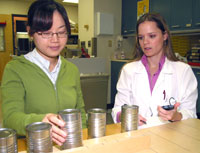
|
|
Hanna observes the Jebsen-Taylor Function Test - one of seven subtests used to evaluate a range of hand functions used in daily activities.
|
I chose to become an occupational therapist because of my early experiences, skills and interests. As a teenager, I became a camp counselor with the United Cerebral Palsy (UCP, http://www.ucp.org/) organization. I had always enjoyed babysitting and working with children, but had never before worked with children with special needs. The work was physically and emotionally challenging, but I completely enjoyed the experience. The campers and their families were so appreciative of, and satisfied with, the camp experience. They taught me about how much you can achieve with motivation, perseverance, adaptability and a little support. Experiences at the UCP summer camps strongly influenced my choice of academic and professional study.
During middle and high school, my favorite subjects were human and developmental studies, anatomy and physiology, sociology and psychology. My interest and ability in these areas of study definitely influenced my decision to pursue a health related profession.
As I entered college, I considered other majors. Through observation, I identified most with the professional philosophy and role of an occupational therapist. I choose to major in psychology as preparation for graduate study in occupational therapy.
Education
Certification
Career Path
- Upper level clinical fieldwork with a pediatric population on the burn, medical and intensive care units and in outpatient programs for brain injury and sensory processing disorders, Riley Hospital for Children, Indianapolis, Indiana
- Upper level clinical fieldwork with adults in the brain injury and spinal cord injury programs, Rehabilitation Hospital of Indiana, Indianapolis, Indiana
- Staff therapist and progressively held positions as senior therapist, supervisor and interim inpatient manager in a community hospital working with a variety of populations in rehabilitation, medical and outpatient programs, Ravenswood Hospital, Chicago, Illinois
- Senior staff occupational therapist participating in research study and clinical care with pediatric behavioral health and physical disability populations of all ages, National Institutes of Health, Bethesda, Maryland
|
|
2. My typical workday involves...
|
Back to Top

|
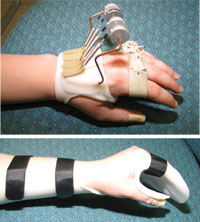
|
|
A metacarpophalangeal extension splint used to strengthen muscles and improve extension (top). A customized resting hand splint used to maintain joint alignment and functional hand positioning (bottom).
|
My typical workday consists of clinical care and research.
My Clinical Tasks
- Patient Evaluation - consists of taking an occupational history to identify problems, concerns and priorities related to a client’s occupations and daily life activities. Performances of activities are analyzed, and specific aspects affecting performance are identified. Aspects that affect performance may include motor, process and communication/interaction skills. Also identified are the habits, routines, roles, context, activity demands and client factors (i.e. attention, memory, sensory function, neuromusculoskeletal function, body structure) that influence performance. Based on this assessment and collaboration with the client/family, the appropriate intervention is identified and implemented or recommended.
- Treatment - Individual and group treatment sessions are client centered, with a focus on engagement in daily life activities that the client finds meaningful and purposeful, and that support participation in various life roles. This may mean adapting the environment and activity demands, as for an individual with physical or behavioral deficits, so that he/she can engage in an activity of choice or necessity and is able to participate in life roles and social communities. Ongoing treatment sessions may also include remediating or restoring performance skills, patterns (habits, routines and roles) and body functions to facilitate adaptive and/or independent performance in various daily occupations.
- Caregiver Training and Education and Family Meetings – These sessions prepare the patient, family members and caregivers to adapt patient care and activities at home or and outside the clinical environment.
- Patient Care and Team Meetings - The professional clinical staff meets regularly to review patient status, and discuss work-related events and activities.
- Clinical Documentation – All patient information, evaluations, and interventions must be documented.
My Research Duties
- Facilitating standardized testing and evaluation
- Managing and analyzing data
- Attending and participating in research team meetings
- Reviewing and studying current scientific literature
- Writing and presenting research results
In research, I test children in drug treatment protocols for purposes of efficacy or outcome. This may involve the use of a standardized assessment (i.e. assessment of motor and process skills, or AMPS) to measure the performance of a daily activity (i.e. making a sandwich, making a bed, setting the table) and visual motor skills. Children are tested while on and off medications and the results are analyzed for a change in performance.
I also participate in natural history studies of children and adults with developmental or genetic disorders. This involves the use of standardized assessments of development, sensory processing and activities of daily living. For this type of study, we can look at developmental and functional characteristics that are specific to a disorder, and compare them to individual case studies over time.
My Work Environment
- The physical work environment is dependent on the client population and status. At times, we work in our clinic where we have a full kitchen and laundry area, training bathroom, and a computer learning area with an ergonomic station. At other times, treatment may take place at the bedside or in the day rooms or community areas in the clinical center. We may also go outside on the campus grounds or into the local community.
- The social environment depends on the client and his or her goals. Family or peers may be involved in the treatment session, and/or there may be co-treatment with other rehabilitation or medical disciplines. Regardless, social participation is encouraged and facilitated according to the client’s ability level and respective to the treatment activity.
Equipment I Use
Occupational therapists often use functional mobility equipment, adaptive devices and orthotics/prosthetics, some of which, may be specially designed to facilitate a client’s engagement in an activity. The equipment I use to assist patients includes:
- Wheelchair – A classic mobility aid for clients with paralysis, amputation and limited use of their legs. Occupational therapists perform customized wheelchair assessments and mobility training, including training to get in and out of a wheelchair and onto other surfaces.
- Sliding Board and Bath Bench - Devices that work together to help clients get in/out of the tub either independently or with assistance. Once seated, a client may then be able to safely shower and/or a caregiver may more easily assist with a shower.
- Splints - Occupational therapists design and fabricate splints in order to provide therapeutic positioning and functioning for the body part splinted.
|
|
3. What I like best/least about my work...
|
Back to Top

|
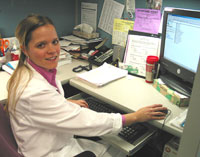
|
|
Hanna does administrative work at her desk.
|
What I like best about my work is getting to know my clients (and their families), learning what is meaningful to them, and sharing in the accomplishment of their goals. It is very rewarding when my clients come to understand how occupational engagement can improve their quality of daily life and participation in their communities.
I feel that I have a special talent and the professional skills to positively contribute to the daily lives of others. As an occupational therapist, you need to have a certain level of persistence, patience, frustration tolerance, and creativity in order to problem solve with the client and to facilitate progress toward success.
The easiest part of my job is the interpersonal interaction. My coworkers are so caring, energetic and committed which makes for a very pleasant working environment. I also enjoy meeting the patients and their families. They demonstrate such resilience and determination in spite of many challenges and hardships. It has a way of putting your own life (and job) challenges in perspective.
What I like least about my work is the paperwork and administrative duties. However, these duties are necessary for assuring clinical and departmental teamwork, and consistent quality patient care. The hardest part of my job is working with clients that have a poor or fatal prognosis.
|
|
4. My career goals are...
|
Back to Top

|
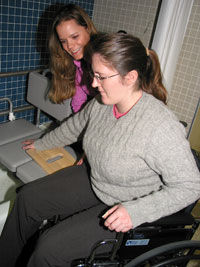
|
|
Hanna instructs and assists in the use of a sliding board that is used to tranfer a patient from a wheelchair to a bath bench.
|
My career goals are to:
- Continue working as an occupational therapist, specializing in pediatrics and behavioral health
- Continue sharing research findings related to occupational therapy with professional communities and other interested parties, and to develop clinical programs based on research findings
- Receive board certification in pediatrics from my professional association, the American Occupational Therapy Association (http://www.aota.org/), and obtain credentials as a mental health specialist and as an early intervention specialist
- Possibly expand my practice in occupational therapy into a different environment or with different populations. I am interested in contributing to the development of community treatment programs in areas with limited occupational therapy services.
- Pursue clinical training in craniosacral therapy (http://www.craniosacral.com/) and kinesiotaping (a therapy based on the science of kinesiology). I regularly seek additional training and education to advance and keep my clinical and research skills current.
|
|
5. When I'm not working, I like to...
|
Back to Top

|
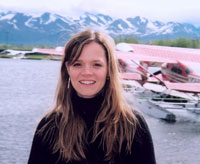
|
|
Hanna in Anchorage, Alaska, waiting to fly over Mount McKinley.
|
When I’m not working, I like to go to the gym, dance, and do just about any outdoor or water activity. I also like to listen to music, drive/ride outside of the city, and watch foreign and independent films. I spend most of my free time in various physical activities, traveling and visiting with friends or family. The hobby I engage in most is sewing, and I’m interested in learning about fashion design.
|
|
|
|
 |